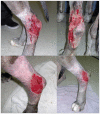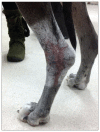Necrotizing fasciitis caused by methicillin-resistant Staphylococcus pseudintermedius at a previously irradiated site in a dog
- PMID: 23633717
- PMCID: PMC3474580
Necrotizing fasciitis caused by methicillin-resistant Staphylococcus pseudintermedius at a previously irradiated site in a dog
Abstract
A great Dane dog was presented with a small, superficial wound on the left tarsus that rapidly progressed to a large necrotic area. The dog had undergone radiation therapy in the left tarsal region 33 months previously. Necrotizing fasciitis was diagnosed on histopathological examination, and bacterial culture revealed methicillin-resistant Staphylococcus pseudintermedius.
Fasciite nécrosante causée parStaphylococcus pseudintermediusrésistant à la méthicilline à un site antérieurement irradié chez un chien. Un chien Grand danois a été présenté avec une petite blessure superficielle sur le tarse gauche qui a rapidement progressé pour devenir une grande région nécrotique. Le chien avait subi de la radiothérapie dans la région du tarse gauche 33 mois auparavant. La fasciite nécrosante a été diagnostiquée à l’examen histopathologique et la culture bactérienne a révélé Staphylococcus pseudintermedius résistant à la méthicilline.(Traduit par Isabelle Vallières).
Figures


Similar articles
-
Staphylococcus pseudintermedius necrotizing fasciitis in a dog.Can Vet J. 2009 Jun;50(6):655-6. Can Vet J. 2009. PMID: 19721787 Free PMC article.
-
Taurolidine susceptibility of methicillin-resistant Staphylococcus pseudintermedius isolates.J Vet Diagn Invest. 2017 Nov;29(6):910-911. doi: 10.1177/1040638717723043. Epub 2017 Jul 28. J Vet Diagn Invest. 2017. PMID: 28754087
-
Meticillin-resistant strains of Staphylococcus pseudintermedius in companion animals.Vet Rec. 2011 Jul 9;169(2):53-4. doi: 10.1136/vr.d4247. Vet Rec. 2011. PMID: 21742696 No abstract available.
-
Severe necrotizing fasciitis in a human immunodeficiency virus-positive patient caused by methicillin-resistant Staphylococcus aureus.J Clin Microbiol. 2008 Mar;46(3):1144-7. doi: 10.1128/JCM.02029-07. Epub 2008 Jan 16. J Clin Microbiol. 2008. PMID: 18199782 Free PMC article. Review.
-
Review on methicillin-resistant Staphylococcus pseudintermedius.J Antimicrob Chemother. 2011 Dec;66(12):2705-14. doi: 10.1093/jac/dkr367. Epub 2011 Sep 19. J Antimicrob Chemother. 2011. PMID: 21930571 Review.
Cited by
-
Understanding the Virulence of Staphylococcus pseudintermedius: A Major Role of Pore-Forming Toxins.Front Cell Infect Microbiol. 2018 Jun 28;8:221. doi: 10.3389/fcimb.2018.00221. eCollection 2018. Front Cell Infect Microbiol. 2018. PMID: 30003063 Free PMC article.
-
Polymicrobial Necrotizing Fasciitis in a Dog: The Involvement of Macrococcus caseolyticus, Proteus mirabilis, and Escherichia coli.Case Rep Vet Med. 2021 Mar 30;2021:5544558. doi: 10.1155/2021/5544558. eCollection 2021. Case Rep Vet Med. 2021. PMID: 33859862 Free PMC article.
-
Staphylococcus pseudintermedius Surface Protein L (SpsL) Is Required for Abscess Formation in a Murine Model of Cutaneous Infection.Infect Immun. 2018 Oct 25;86(11):e00631-18. doi: 10.1128/IAI.00631-18. Print 2018 Nov. Infect Immun. 2018. PMID: 30181348 Free PMC article.
-
Antibacterial and Antivirulence Activity of Manuka Honey against Genetically Diverse Staphylococcus pseudintermedius Strains.Appl Environ Microbiol. 2020 Oct 1;86(20):e01768-20. doi: 10.1128/AEM.01768-20. Print 2020 Oct 1. Appl Environ Microbiol. 2020. PMID: 32801179 Free PMC article.
-
Antimicrobial susceptibility of Staphylococcus pseudintermedius colonizing healthy dogs in Saskatoon, Canada.Can Vet J. 2016 Jan;57(1):65-9. Can Vet J. 2016. PMID: 26740701 Free PMC article.
References
-
- Naidoo SL, Campbell DL, Miller LM, et al. Necrotizing fasciitis: A review. J Am Anim Hosp Assoc. 2005;41:104–109. - PubMed
-
- Jamal N, Teach SJ. Necrotizing fasciitis. Pediatr Emerg Care. 2011;27:1195–1199. - PubMed
-
- Betschel SD, Guru V, Miller CW, et al. Canine toxic-shock syndrome. An emerging disease? Adv Exp Med Biol. 1997;418:189–92. 189–192. - PubMed
-
- Prescott JF, DeWinter L. Canine streptococcal toxic shock syndrome and necrotising fasciitis. Vet Rec. 1997;140:263. - PubMed
Publication types
MeSH terms
Substances
LinkOut - more resources
Full Text Sources
Medical
